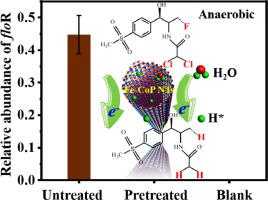Water Research ( IF 12.8 ) Pub Date : 2021-06-13 , DOI: 10.1016/j.watres.2021.117361 Huiling Liu 1 , Yangcheng Ding 2 , Haifang Tang 3 , Yi Du 1 , Danyu Zhang 1 , Yanhong Tang 3 , Chengbin Liu 1

|
Resistance gene expression and microbial inhibition by halogenated antibiotics is a major environmental concern. Although electrocatalytic dehalogenation can detoxify halogenated antibiotics, the effect of dehalogenation treatment on resistance gene expression and microbial inhibition is poorly understood. Herein, a novel electrocatalyst of Fe-doped CoP nanotubes array on nickel foam (Fe-CoP NTs/NiF) is prepared through a simple ultrasonication of Fe-doped CoP nanowires hydrothermally grown on NiF. The transformation from nanowires to nanotubes improves the crystallinity of CoP and fully exposes active sites, producing energetic atomic hydrogen for dehalogenation. Fe-CoP NTs/NiF exhibits a superior dehalogenation performance towards refractory florfenicol (FLO), achieving 100% removal within 20 min (‒1.2 V vs Ag/AgCl, C0 = 20 mg L‒1). The dechlorination ratio reaches nearly 100%, and the defluorination ratio achieves 36.8% within 50 min, showing the best electrocatalytic dehalogenation performance reported so far. Microbial community and correlation analysis show that Proteobacteria is the main potential host of FLO resistance gene. Electrocatalytic reductive dehalogenation pretreatment of FLO can reduce microbial inhibition, maintaining microbial richness and diversity in the subsequent biochemical treatment unit. The electrocatalytic reductive dehalogenation treatment can significantly reduce the relative abundance of FLO resistance gene, showing a reliable process for safe treatment of halogenated antibiotic containing wastewater.
中文翻译:

使用Fe掺杂的CoP纳米管阵列对氟苯尼考进行电催化深度脱卤,以阻断生化处理过程中的耐药基因表达和微生物抑制
卤代抗生素的耐药基因表达和微生物抑制是一个主要的环境问题。尽管电催化脱卤可以对卤化抗生素进行解毒,但对脱卤处理对耐药基因表达和微生物抑制的影响知之甚少。在此,通过对在 NiF 上水热生长的 Fe 掺杂 CoP 纳米线进行简单的超声处理,制备了一种新型的 Fe 掺杂 CoP 纳米管阵列在镍泡沫上的电催化剂(Fe-CoP NTs/NiF)。从纳米线到纳米管的转变提高了 CoP 的结晶度并充分暴露了活性位点,产生用于脱卤的高能原子氢。Fe-CoP NTs/NiF 对难熔的氟苯尼考 (FLO) 表现出优异的脱卤性能,在 20 分钟内实现 100% 去除(‒1.2 V vsAg/AgCl,C 0 = 20 mg L ‒1 )。脱氯率接近100%,50分钟内脱氟率达到36.8%,显示出迄今为止报道的最佳电催化脱卤性能。微生物群落及相关性分析表明变形菌是FLO抗性基因的主要潜在宿主。FLO的电催化还原脱卤预处理可以减少微生物的抑制,保持后续生化处理单元中微生物的丰富度和多样性。电催化还原脱卤处理可以显着降低FLO抗性基因的相对丰度,显示出一种安全处理含卤化抗生素废水的可靠工艺。


























 京公网安备 11010802027423号
京公网安备 11010802027423号